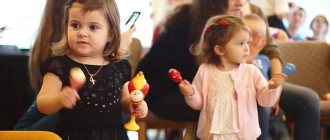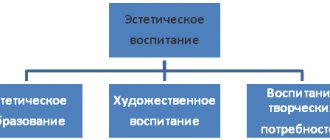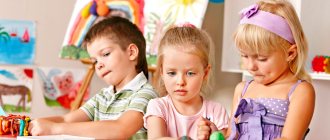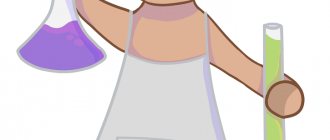Aesthetic education in pedagogical science is the formation of the ability to perceive and appreciate beauty in the world around us. The younger generation is developing a system of criteria that evaluates the aesthetics of various objects.
Aesthetic perception correctly established in childhood helps in the future to create beautiful things and introduce the principle of aestheticism into everyday life. A craving for beauty contributes to the development of a child’s creative abilities and shapes artistic taste.
Articles on the topic
- Raising a child by a father: what is important for a baby 01/25/2022
- Types of education: main tasks and goals 01/24/2022
- Parenting with freedom or how to raise a confident child 01/23/2022
- What does education through art give children 01/21/2022
Aesthetic education is an integral part of human culture as a whole. It acts as a catalyst for the development of spirituality, an indicator of human behavior in society. The lack of deep aesthetic attitudes is reflected in a course of action that contradicts general humanitarian principles.
Goals and objectives
A person deeply imbued with a sense of beauty transfers the criteria of aestheticism not only to inanimate objects, but also to relationships with others. The aesthetics of feelings contributes to the rooting of the ideas of humanism, spirituality, and morality.
The goal of aesthetic education of schoolchildren is to contribute to the formation of a comprehensively developed personality and to develop artistic taste.
The primary tasks of aesthetic education include:
- Accumulation in consciousness of impressions of beauty.
- Formation of artistic taste.
- Development of cognitive interest in phenomena and objects included in the fund of world culture.
- Stimulating the desire for creativity.
Contents of aesthetic education
The content of electronic learning includes the formation of skills, tastes, needs, interests, standards and assessments. As a result of a joint form of artistic activity, children gain new knowledge that helps them understand the essence and diversity of the world around them.
They learn to distinguish between good and bad, ugly and beautiful, good and evil, comic and tragic. Against the background of the acquired information, the concept of aesthetic culture comes as the most multifaceted, sublime area.
Preschoolers get acquainted with art from the first years of life, through arts and crafts architecture, sculpture, painting, and folk art. In kindergarten, children begin to actively engage in independent artistic activities - they draw, sculpt from plasticine, cut out crafts, sing, dance.
The teacher must provide the necessary conditions for comfortable and effective completion of tasks, provide support, and give students the right direction. A correct program, which includes a variety of forms of EV, guarantees the fulfillment of all functions and the comprehensive aesthetic development of the personality of a child of preschool and school age.
Under the clear guidance of a teacher or adult, children must understand the main criteria that serve as an assessment in the distinction between bad/good, sublime/ordinary, beautiful/ugly, in order to then apply the experience gained in later life.
Methods and means
To form a system of aesthetic values in children, a traditional triad of methods is used - visual, verbal, practical. In addition, there are also special techniques.
They are aimed at developing aesthetic views through:
- exploring the beauty of the natural environment;
- introduction to various types of art (music, painting, literature, theater);
- engaging in productive work activities.
The introduction of each method requires the use of appropriate means of aesthetic education. The maximum effectiveness is achieved by introducing students to works of art - paintings, sculptures, architectural buildings. Their images are used for demonstration in the form of visual aids.
Natural objects have a tangible impact on the formation of a person’s aesthetic views. The uniqueness of the landscapes inherent in the native land leaves an imprint on the basic ideals of beauty, which are laid down in the child’s mind from childhood. Objects of flora and fauna inherent in the natural area where people live are also unique means of aesthetic education.
The needs for aesthetic values are formed through interpersonal communication. First of all, the culture of language and speech must be improved.
This concerns the alienation of parasitic words, the normalized use of foreign terms and slang, and correct pronunciation.
Objectives of aesthetic education
The implementation of the previously listed goals is not possible without a clear formulation and implementation of a number of pedagogical tasks. They, in turn, are divided into two categories:
The first group is aimed at developing an aesthetic attitude in children. In this case, the following tasks must be performed:
- formation of the sensory side of personality;
- developing the ability to see beauty and uniqueness in people, objects, nature, art, society;
- acquaintance with the basic standards, individual cultural qualities and manifestations of personality, as well as the gradual introduction of new terminology into the student’s colloquial vocabulary;
- understanding the essence of beauty;
- education in students of unique features, ideas, reasoning, concepts that play an explanatory role in understanding all aesthetic components;
- emotional development – the ability to give an adequate reaction (joy, laughter, disappointment, agreement, etc.) in any situation.
Musical education of preschool children
The second group - pedagogical tasks are to encourage children to perform artistic and aesthetic activities, to develop and acquire certain skills and abilities. Various methods are used to introduce schoolchildren and preschoolers to art/culture (for example, drawing, modeling, singing, dancing, reading poetry). In addition, a desire is formed to bring and apply the acquired skills in real life.
Formation of aesthetic views in different age groups
The method of instilling aestheticism in children is based on their sensitivity to different categories of objects, depending on age. As an individual grows older, his sensitive emphasis on nature and society changes.
The famous Russian teacher P. Blonsky built a scale of sensitivity:
- color;
- item;
- plants and animals;
- scenery;
- objects of art;
- Human.
Preschoolers
The first general concepts and images are formed in the baby by the age of 2. He moves from episodic perception of reality to purposeful observation. Memory and thinking gradually develop.
Young children are impressionable and emotional. Pleasant emotions are stored in memory and encourage their repetition. During this period, the child reacts positively to music, modeling, and drawing. First of all, his senses work - touch, hearing and vision.
Preschoolers easily remember notes, learn to distinguish colors and combine them harmoniously. Much attention is paid to creating three-dimensional images and models. Children enjoy modeling, designing, and handicrafts.
Primary School
The perception of elementary school students still remains scattered, mosaic, and superficial. The child does not hold attention on one subject for a long time. He is more interested in the dynamics of the plot than in the descriptive picture.
To get acquainted with works of art, you need to select illustrations that have a clearly defined storyline.
In terms of cultural development, younger schoolchildren are recommended to visit the theater. Literary works performed on stage by actors create a powerful emotional background. The child empathizes with the characters and enjoys watching the production.
The introduction to art continues. Primary school students are more focused on the process of handicraft than on the final result itself. The restraining factor is the restlessness and increased activity of children of primary school age.
Teenagers
Students in secondary school already have basic knowledge of aesthetics and are able to apply them in practice. However, the desire to stand out from the general environment often throws teenagers to extremes, blurring the line between the beautiful and the ridiculous, the absurd.
The conditions of modern life dictate new approaches to the formation of aesthetic views. It is necessary to consider not only classical art movements, but also the latest art trends.
Young people are primarily interested in:
- music - rap, rock;
- painting – computer graphics, graffiti;
- literature - comics.
Graduates
High school students have a system of ideological views. Through their prism, they perceive the aesthetic essence of surrounding objects and phenomena. The main attention is paid to the consideration of the aesthetic aspects of human behavior and interpersonal relationships.
Goals of aesthetic education
The main goal is the formation of an individual’s aesthetic culture. An aesthetically educated child develops virtuous, moral, and spiritual values; His knowledge about nature, society, and the essence of the world expands.
Various artistic activities develop character traits such as attentiveness, perseverance, and discipline. Therefore, the goals of EV should also include:
- the formation of a holistic personality capable of openly expressing one’s thoughts, speaking out, expressing oneself, sympathizing and empathizing in various life situations;
- the development of a highly moral, harmonized, multifaceted person, distinguished by his uniqueness from other individuals.
How to teach a child to dance: easy dances for beginners
During the period of artistic education, the following aesthetic components are formed, necessary for the generality and quality of the process:
- Perception is the ability to identify aesthetic features in everyday, cultural and social life. Subsequently, what is perceived is assessed by the individual according to personal criteria formed as a result of receiving emotional and intellectual experience.
- Feelings are the manifestation of emotions that arise as a result of interaction with another person, art, environment or society. Such feelings can cause pleasure, joy, inspiration, sadness or disgust. They are associated with more complex intellectual and emotional processes, and are also distinguished by their depth, variety, and complexity. But despite this, such persistent emotions are always in harmony with the mind.
- Interest is a person’s desire for new knowledge. The main criterion of aesthetic interest is whether an individual has favorite works of art, writers, composers; books that he often rereads; the presence of purposefulness in choosing the genre of music and literature.
What is ↑
The word “aesthetics” translated from ancient Greek means “sensory perception” and is the doctrine of the external form and internal content of beauty in nature, social life, and the inner world of man.
Aesthetic education is the development in a person of the ability to perceive, appreciate, analyze and create beauty in everyday life and art.
Here it should be clarified that the concept of “beautiful” in the context of the artistic formation of personality does not coincide with the meaning of the words “beauty, beautiful.” The latter is rather a description of the external form, which depends on a specific historical era and may change.
“Beautiful” is independent of time and includes such concepts as harmony, humanism, perfection, sublimity, spirituality.
Tips and tricks for parents
It is important to carry out aesthetic education of the child by all available means, creating a harmonious environment for him, giving him the opportunity to independently engage in artistic creativity in the chosen direction. Parents need to talk with the baby and give answers to all the questions he has. And classes with a teacher will help develop taste.
When choosing forms of work, you should focus on the age of the baby:
- Visiting the theater is permissible from 1.5 years of age; the repertoire of puppet theaters includes short-lasting productions that will not have time to tire the baby.
- You can talk about paintings, musical works, and talk about their authors from the age of 3–4; children already understand a lot and will definitely listen with interest and ask questions.
- At 4–5 years old you can visit an exhibition, including a library one.
- At 5-6 years old - go to the Philharmonic or ballet.
Giving a child the opportunity to create is another method of aesthetic education, and he can choose the type of activity to his liking. Some people like to draw pictures in the sand, while others like to write short congratulatory poems for mom or dad. Parents should not limit creative impulses, but give their child the freedom to choose and realize their own ideas.
Do not underestimate the importance of aesthetic education for preschoolers; it will help to spiritually enrich the child’s personality, make him developed, rich, able to feel subtly and receive aesthetic pleasure.







